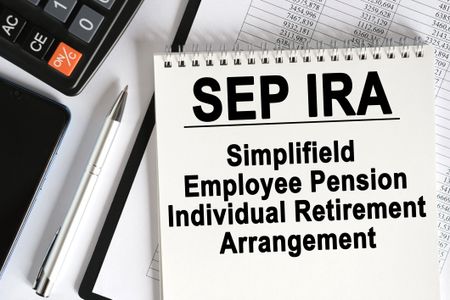Kiplinger's Recipes for Quick & Easy Financial Fixes
Each of our recipes for financial success takes 15 minutes or less to cook up. You'll be surprised how much you can accomplish in so little time.

Dive into this package via our interactive application to view, print, and share individual "recipes" for financial fixes -- or read through the text version below by clicking on topics that interest you.
Banking | Identity Theft / Credit Monitoring | Taxes | Insurance | Home | Investing | Retirement | Paying for College | Career | Travel | Computer Security
Banking
PUT YOUR SAVINGS ON AUTOPILOT

Sign up for Kiplinger’s Free E-Newsletters
Profit and prosper with the best of expert advice on investing, taxes, retirement, personal finance and more - straight to your e-mail.
Profit and prosper with the best of expert advice - straight to your e-mail.
There is less to think about when you transfer cash automatically to savings and investing accounts.
Ingredients:
-- Internet access
-- An online bank account for receiving your paycheck
-- A savings account or money-market fund, a brokerage or mutual fund account, and routing numbers
Instructions:
1. Sign in to your bank account, and click on Transfers.
2. Set up a recurring transfer to a savings account or money fund for your emergency cash.
3. Set up another to your brokerage or mutual fund account to build your investments.
Total time: 3 minutes
SET UP CREDIT-CARD PAYMENT ALERTS
Those $39 late fees add up. In 2009, banks collected more than $19 billion from procrastinating cardholders.
Ingredients:
-- Internet access
-- A user ID and password
Instructions:
1. At the American Express Web site, you log in, then choose See Account Management Options.
2. Click on Update Account Alerts, and check Payment Reminder. The reminder can be from one to ten days before the due date.
The process is similar at other card Web sites.
Total time: 7 minutes, including registering the accounts
STOP BOUNCING CHECKS AND PAYING NUISANCE FEES
Charges can be as high as $38 per instance when you overdraw your account. Banks raked in $38 billion from such fees in 2009.
Ingredients:
-- Internet access
-- Social Security number
-- Bank-account number
-- Other personal information
Instructions:
1. Go to your bank's Web site, and select Overdraft Protection.
2. Click to link to a savings or money-market account. That prevents you from bouncing a check and costs less.
Most banks also let you sign up for an alert that warns you when your balance approaches a specified level.
If you need to open the account you're linking to, a bank representative may call later.
Total time: 11 minutes to sign up for both the alert and the linked account
RENT A SAFE-DEPOSIT BOX
Protect your valuables and documents from theft and fire.
Ingredients:
-- Photo identification
-- An appointment
-- Resealable plastic bags
Instructions:
1. Pick a bank branch close to home, in case you need quick access to your safe-deposit-box contents.
2. To hold down the time, make an appointment.
3. Why the plastic bags? Many banks recommend that you seal documents in a waterproof bag in case of a flood.
Total time: 14 minutes, not including time to travel to the bank
Identity Theft / Credit Monitoring
GET YOUR CREDIT SCORE
A good score and credit history can get you a great rate. A bad record could keep you from getting a loan.
Ingredients:
-- Internet access
-- Social Security number
-- Date of birth
-- Address
Instructions:
1. Go to AnnualCreditReport.com, select your state, click on Request Report and provide the information requested.
2. You'll be guided to each of the three credit bureaus' sites to answer a few more questions.
Each bureau gives you the option to get your credit score (for $7.95) with each report (free every 12 months).
Total time: 13 minutes
CORRECT YOUR CREDIT RECORD
An erroneous entry, such as a debt in collection, could cause your score to drop by 100 points.
Ingredients:
-- Internet access
-- Your credit reports within 30 days of getting them
Instructions:
Read through each report, noting any negative items. If you've just gotten your report, you'll see a link to start a dispute of any errors. Otherwise, each credit bureau's Web site (www.transunion.com, www.experian.com, www.equifax.com) provides a link.
If the error started with the company reporting it, go to the source of the problem.
Total time: 15 minutes to initiate a complaint; resolution will take longer
COPY EVERYTHING IN YOUR WALLET (EXCEPT THE CASH)
If your wallet is lost or stolen, suspending accounts and getting replacement cards will be far easier.
Ingredients:
-- Your wallet or purse
-- Copier or scanner
-- File folder
-- Secure household location big enough to hold your file
Instructions:
1. Pluck out items from your billfold or purse that you need -- credit cards, insurance cards, IDs, frequent-traveler cards . . . you get the idea.
2. Then copy or scan both sides of the items. Note that the customer-service number you need to call to report a compromised card is often on the back.
Total time: 3 minutes
Taxes
TRACK DOWN YOUR INCOME-TAX REFUND
Everyone could use extra cash, and it's nice to know when the check will arrive.
Ingredients:
-- Internet access
-- Your tax return
Instructions:
1. Visit IRS.gov’s Where’s My Refund? tool.
2. Enter your Social Security number, filing status and the amount of the refund shown on your return.
3. The site will confirm whether your return was received and processed and estimate when your refund will be mailed or deposited into your bank account.
Total time: 3 minutes
ADJUST YOUR TAX WITHHOLDING TO GET A BIGGER PAYCHECK
Nice as a tax refund may be, it means you gave Uncle Sam an interest-free loan. Better to keep that money by reducing the taxes withheld from your paycheck.
Ingredients:
-- Internet access
-- Your 2009 tax return
-- Your latest pay stub
-- Form W-4, available at www.irs.gov or from your employer's personnel department
Instructions:
1. Start with Kiplinger's easy-to-use withholding calculator to determine how much you might add to your paycheck.
2. Go to IRS.gov’s Withholding Calculator.
3. Fill in your filing status, copy information from your 2009 tax return to fill in tax-credit information (such as the number of child credits you can claim for your kids under age 17), and key in information from your latest pay stub about your current income and tax withholding. You'll also have to make some educated guesses about your other income and expenses for 2010.
4. The calculator tells you how many allowances to claim.
5. Fill out a new Form W-4, and submit it to your employer.
Total time: Up to 15 minutes, depending on the complexity of your tax return
Insurance
LOWER YOUR AUTO PREMIUMS
Insurance is a competitive business. If you shop around a bit, you're likely to get a better deal.
Ingredients:
-- Internet access
-- Basic information about your car
Instructions:1. Go to CarInsurance.com, and answer questions about your cars and your driving record.
(If time allows, you also can get quotes at Geico.com and Progressive.com, which will let you buy the policies online. You'll need to provide your Social Security number for a precise rate.)
Or contact an independent agent, who can search for you.
2. You'll get preliminary quotes from several insurers.
3. Consider the rates and terms to determine which deal is best for you.
Total time: 15 minutes
PAY LESS FOR LIFE INSURANCE
Premiums have been dropping for a decade.
Ingredients:
-- Internet access
-- Cholesterol level and blood pressure
-- Height and weight
Instructions:
1. Go to Accuquote.com, and type in information about your health, family medical history and hobbies.
2. You'll get prices for term insurance from several firms.
3. Click on your favorite, and apply online (the final price depends on the results of a medical exam).
Or call 800-442-9899 begin_of_the_skype_highlighting 800-442-9899 end_of_the_skype_highlighting for a quote, especially if you have medical issues.
Total time: 15 minutes
UPDATE YOUR HOMEOWNERS POLICY
Your home may be worth more than it's insured for.
Ingredients:
-- Internet access
-- Year your home was built
-- Size of living area
-- Size of attached features
Instructions:
Visit AccuCoverage.com to verify the current replacement value for your home of up to 5,000 square feet and containing up to four units.
Fill in a worksheet to create a report ($7.95) based on your information and the reconstruction-cost data that the insurance industry uses.
Total time: 15 minutes
KEEP THE BLING IN YOUR RING
Even one loose prong weakens the setting, risking the loss of your sparkler.
Ingredients:
-- A jeweler with a loupe
Instructions:Walk into the store, and ask the jeweler to take a look. He or she should be willing to do it free.
Some jewelers will also clean the ring as a courtesy.
Total time: 1 minute for the ring check; 5 minutes for cleaning
SNAP DIGITAL PHOTOS OF YOUR HOUSEHOLD BELONGINGS
The images will help back up an insurance claim if your possessions are destroyed or stolen.
Ingredients:
-- Digital camera
-- USB flash memory drive
-- Computer
Instructions:
1. Take shots of the significant items in your house.
2. Download the images to the flash drive or upload them to the Web so you can access them off-site.
3. Ideally, the images will be the starting point for a complete household inventory, in which you itemize your furniture, jewelry and collectibles and record details such as purchase price. Visit the Insurance Information Institute's Know Your Stuff tool to maintain an online record.
Total time: 14 minutes for a four-bedroom home (actual time will vary according to number of possessions)
Home
CALL IN A PRO TO HELP CUT YOUR ENERGY BILLS
For a rigorous evaluation of your home's energy use and specific recommendations for improving its efficiency, call an energy auditor. You can cut your energy use by as much as half and reap federal tax credits and state rebates for qualified home improvements.
Ingredients:
-- Internet access
-- 12 months of utility bills or a summary of your usage
Instructions:
To find an auditor, visit EnergyStar.gov’s Home Performance with Energy Star section.
Or, visit the Residential Energy Services Network’s site to Find a Certified Rater.
An audit typically takes three to four hours and costs $250 to $600.
Total time: 15 minutes for gathering the bills, consulting Web sites and making a call
EQUIP YOUR HOME WITH NEW SAFETY DEVICES
Guard against accidents, and keep your family safe.
Ingredients:
-- Smoke detector
-- Carbon-monoxide detector
-- Fire extinguisher
Instructions:
1. Head to a big-box store, where you'll usually find the three essential pieces of hardware located in the same aisle. Expect to pay:
* about $15 for a smoke alarm
* about $30 for a carbon-monoxide detector (for another $20 you can get a CO detector that also detects explosive gases -- not a bad idea if you heat or cook with natural gas)
* about $40 for a heavy-duty fire extinguisher
2. Detectors should be placed near bedrooms (because fire and CO accidents occur most often while you sleep) and near an attached garage.
Total time: 13 minutes, not including travel time to the store
Investing
MAKE A FIRST DATE WITH A FINANCIAL PLANNER
You need help with a crucial decision, such as figuring out how to invest a six-figure insurance payout or how you'll pay for your kid's education.
Ingredients:
-- Internet access
-- Telephone
Instructions:
1. Visit NAPFA.org to locate planners in your area. (If you have time to spare, you can also search at the Garrett Planning Network and the Financial Planning Association for other names.)
2. Research a few to see whose skills and resources mesh with your situation.
3. Call to schedule a free, no-obligation meeting.
Total time: 15 minutes
TAKE AN X-RAY OF YOUR FUND PORTFOLIO
See how well diversified your mix is.
Ingredients:
-- Internet access
-- Portfolio of mutual funds
-- Current fund statements
Instructions:
1. Visit Morningstar.com’s Instant X-Ray tool.
2. Insert your funds' symbols in the first column, put the dollar value or percentage value of each holding in the second, and hit the Show Instant X-Ray button.
3. Behold, you will see how your portfolio breaks down – how much is in each region of the world, in each stock sector (energy, utilities and so on) and in each investment style (such as large growth or small value). Plus, you can get portfolio statistics, such as the average price-earnings ratio of your stocks and the average expense ratio of your funds (and the amount you pay in annual fees).
The service is free. A more detailed probe of your portfolio requires a premium membership, which costs $179 per year, but the site offers a 14-day free trial.
Total time: 8 minutes for a six-fund portfolio
FIND YOUR RISK TOLERANCE
Create an investment plan that suits your goals and fits your personality.
Ingredients:
-- Internet access
Instructions:
1. Go to Kiplinger.com’s Risk Tolerance and Asset Allocation calculator.
2. Complete the assessment to estimate how much of your money you should invest in stocks, with the rest in lower-risk investments.
3. Consider the suggested allocation, and invest appropriately.
Total time: 2 minutes
ESTABLISH THE RIGHT MIX OF MUTUAL FUNDS FOR YOU
Low-risk stuff pays nothing nowadays, so you need to invest in stocks and bonds to earn a decent return.
Ingredients:
-- Internet access
-- The result of your risk-tolerance test
Instructions:
1. See the model portfolios we've assembled using Kiplinger 25 funds.
2. Choose the portfolio that most closely matches your recommended allocation to stocks. Tweak the allocations if your target for stocks doesn't align closely with one of the model portfolios.
If you're investing in a taxable account, consider using the Fidelity muni-bond fund for some or all of your bond allocation.
Total time: 5 minutes
BUY MUTUAL FUNDS
Ingredients:
-- Internet access
-- A brokerage account
-- Your perfect portfolio
-- A calculator
Instructions:
1. Translate your portfolio's allocations from percentages to the actual dollar amounts you plan to invest.
2. Next, log in to your brokerage account, and go to Trade.
3. Place your orders.
Total time: Up to 15 minutes
SEE WHETHER YOUR FUND MANAGERS HAVE SKIN IN THE GAME
If the fund manager has money alongside yours, your interests are aligned.
Ingredients:
-- Telephone or Internet access
-- Money in a mutual fund
Instructions:
Read a fund's Statement of Additional Information to find out whether your manager has money in the fund. The SAI will describe a manager's investment in broad dollar ranges, from zero to more than $1 million.
The SAI is usually available on the fund's Web site. If not, call the sponsor and ask that the document be mailed to you.
Total time: 5 minutes online, or about 10 minutes over the phone
INVESTIGATE YOUR BROKER
See whether your broker is telling the truth about his or her past.
Ingredients:
-- Internet access
-- Name of broker or brokerage firm
Instructions:
The Financial Industry Regulatory Authority offers a free service that lets you see the disciplinary record of more than 850,000 brokers and their firms.
1. Go to FINRA.org’s BrokerCheck, and click the Start Search button.
2. Type a name in the search bar, make sure to indicate whether it is that of a broker or brokerage firm, and click the Start Search button again.
3. The site will prompt you to type in a numerical code to make sure you aren't a spam bot.
4. Click on the name of the broker or firm, and a snapshot report will appear.
5. Select the Get Detailed Report link in the right-hand column for the juicy tidbits.
Total time: 4 minutes
VOTE YOUR PROXY AS AN INVESTOR
Weigh in on executive pay and other corporate-governance issues.
Ingredients:
-- Internet access
-- Your 12-digit proxy control number (it's in a box or next to an arrow on your proxy notification)
Instructions:
1. Register at MoxyVote.com.
2. Once registered, you can click on the red Vote Now box on the home page.
3. Keying in your proxy control number brings up the ballot, which shows management's suggested vote as well as suggestions from shareholder advocates who have registered on the site.
4. Mark the ballot, hit the Submit button, and you're done.
Total time: 5 minutes (including registration; without registration, less than 2 minutes)
BUY TREASURIES STRAIGHT FROM THE SOURCE
You can buy U.S. Treasury bills, bonds and inflation-protected securities without paying a commission by establishing an account with the Treasury.
Ingredients:
-- Internet access
-- Driver's license
-- Social Security number
-- Bank account
Instructions:
1. Follow the instructions to open an account at TreasuryDirect.gov.
2. You'll need to enter your driver's-license number, Social Security number and bank-account routing information, which you'll find on your checks.
3. The Treasury will send you an e-mail confirming your registration.
4. Shortly thereafter the Treasury will snail-mail you an access card.
5. Return to the site to start buying Treasury securities.
Total time: 5 minutes (plus waiting time for access card to arrive in the mail)
Retirement
BE SURE YOU'RE SAVING ENOUGH FOR RETIREMENT
Better to find out now whether you're falling short of your target, while you still have time to boost your savings.
Ingredients:
-- Internet access
-- General estimates of how much you have already saved
-- Your projected Social Security benefits
-- How much you expect from a pension
-- When you expect to retire
Instructions:
1. Go to Kiplinger.com’s Retirement Savings Calculator.
2. Fill in information about your salary, accumulated savings and future sources of retirement income.
3. Our calculator will estimate how much you need to save each month to reach your goal.
If that amount is more than you are currently saving, consider boosting your 401(k) contribution. Ideally, you should strive to save 15% of your gross salary (including employer contributions) over your career. Get a late start, and you might have to boost your savings to 25% or more of your pretax income, postpone your retirement date, or both.
For 2010, you can contribute up to $16,500 to your 401(k) or similar employer-based plan or up to $22,000 if you are 50 or older.
Total time: 5 minutes
SET UP A GREAT RETIREMENT SAVINGS PLAN AT WORK
You'll cut your taxes and maybe get free money. And you can rebalance automatically to take the emotion out of your decisions.
Ingredients:
-- Your 401(k) enrollment form
-- A plan for divvying up your assets
Instructions:
1. Choose the type of 401(k) plan you prefer. For an upfront tax break, elect the traditional 401(k). If you prefer deferred gratification, choose the Roth 401(k), if your plan offers it.
2. Select your investments.
3. Finally, fill out the part that asks you to name beneficiaries, so that your money will fall into the right hands.
Total time: 7 minutes
CALCULATE YOUR FUTURE SOCIAL SECURITY BENEFITS
You'll know how much you can expect as a basic income stream in retirement.
Ingredients:
-- Internet access
-- Social Security number
-- Date of birth
-- Mom's maiden name
Instructions:
1. Go to the Social Security Administration’s online Retirement Estimator, and provide the information requested.
2. The Retirement Estimator calculates your benefits based on your actual earnings history. Estimates are given for early reduced benefits at age 62, full benefits at your normal retirement age and maximum benefits available at age 70.
You must be younger than 62 and not currently receiving benefits to use the estimator.
Total time: 2 minutes
LEAVE YOUR CASH TO THE ONES YOU REALLY LOVE
The beneficiary designations on your mutual fund and brokerage accounts supersede those in your will. If the information is out of date, the wrong person could inherit your money. Most brokerages and mutual fund firms make it easy for you to change your beneficiary.
Ingredients:
-- Internet access
-- IDs and passwords for your accounts
-- New beneficiaries' Social Security numbers, dates of birth and addresses.
Instructions:
1. Log on to each account, and click on Beneficiaries to make sure the names and their contact information are up to date.
2. As necessary or desired, change the names of beneficiaries or reallocate the share of the account they will inherit.
Total time: 5 minutes to 15 minutes, depending on number of changes
Paying for College
ESTIMATE HOW MUCH YOU NEED TO SAVE FOR COLLEGE
The sooner you know what you're up against, the earlier you can start saving.
Ingredients:
-- Internet access
-- Information about college costs
-- Your child's age
Instructions:
1. Visit SavingforCollege.com’s World's Simplest College Cost Calculator.
2. If you plan to send your student to a private college, enter $35,636 -- the current average annual cost. It's $15,213 for in-state tuition at a public school.
3. Also, enter how much you have saved already and what kind of investment return you expect for your college fund. (You can also use the calculator's default settings.)
4. The calculator will deliver an instant verdict on how much you need to be saving each month.
Total time: 1 minute
GET A FAST READ ON FINANCIAL AID
You'll get a rough idea of what you can expect to gain by filing a Free Application for Federal Student Aid, which puts you in the pool for federal grants and loans and other aid.
Ingredients:
-- Internet access
-- Basic financial details, such as income and savings
Instructions:
1. Visit Finaid.org’s Expected Family Contribution and Financial Aid Calculator.
2. Fill in ten boxes or fewer, and hit Calculate.
Total time: 1 minute
Career
IMPROVE CAREER OPPORTUNITIES
If you need a new job quickly, you're going to wish you had stayed in touch.
Ingredients:
-- Internet access
-- LinkedIn account
Instructions:
1. Set up an account at LinkedIn.com, the business-oriented social-networking site.
2. List some of your key professional accomplishments.
3. Identify five people who could most advance your career, and start building a relationship with them.
If you think of people who aren't on LinkedIn, write them an old-fashioned letter.
Total time: 15 minutes
Travel
KEEP TRACK OF YOUR TRAVEL REWARDS
Travelers have earned some ten trillion airline miles that remain unused. The miles, worth about $165 billion in tickets, are at risk of flying out the window.
Ingredients:
-- Telephone or Internet access
-- Your travel-rewards account numbers
Instructions:
Call each airline loyalty program you have an account with, provide your ID number and instantly get the scoop on expiration dates for your miles and your recent mileage activity. To view the same data online, open an account with the company's Web site.
Or sign up with AwardWallet.com to manage multiple rewards accounts with airlines and other companies.
Total time: Less than 5 minutes per account
Computer Security
ENCRYPT YOUR WI-FI
About one million identity-fraud victims last year were compromised online, says Javelin Strategy and Research.
Ingredients:
-- Internet access
-- Your wireless-router address, user name and password
Instructions:
1. Enter the router address in your Internet browser.
2. Log in, and hit the Wireless tab.
3. Select Wi-Fi Protected Access (WPA), and create a unique password to go with it. Set up a network name and administrative password, too.
Total time: 5 minutes
STAY VIRUS-FREE
Protect your computer from bugs.
Ingredients:
-- Internet access
Instructions:
Download one or two malware-protection services available free online. We recommend PC Magazine's Editor's Choice: Panda Cloud Antivirus 1.0. Or try Microsoft's own Security Essentials.
Total time: 5 minutes
BLOCK SPAM
Enhance your e-mail's spam filter and spend less time sifting through the trash folder.
Ingredients:
-- Internet access
-- An e-mail account
Instructions:
Download a free, Web-based spam blocker, such as MailWasher Free, to stop the junk before it hits your in-box.
Total time: 5 minutes
BACK UP YOUR FILES
Ingredients:
-- External hard drive or Internet access
Instructions:
Copy all your important files to an external hard drive, which typically costs $80 for 160 gigabytes.
Or try a free online backup service, such as Windows Live SkyDrive with 25 gigabytes of storage.
Total time: 15 minutes
RECORD PASSWORDS
Ingredients:
-- Pen and paper
-- Secure household location big enough to hold the paper
Instructions:
Keep a running list of your online accounts with their user names and passwords in a secure, offline place, such as a fireproof safe. If you store IDs and passwords on your computer, you run a higher risk of having this data stolen.
Total time: 30 seconds per account
Get Kiplinger Today newsletter — free
Profit and prosper with the best of Kiplinger's advice on investing, taxes, retirement, personal finance and much more. Delivered daily. Enter your email in the box and click Sign Me Up.
-
 Winning Strategies for Financial Advisers as Clients' Lives Evolve
Winning Strategies for Financial Advisers as Clients' Lives EvolveHow can the wealth management industry help make life transitions easier for the adviser and the client?
By David Conti, CPRC Published
-
 How Advisers Can Establish Relationships With HNW Prospects
How Advisers Can Establish Relationships With HNW ProspectsThese strategies can help to build influence with high-net-worth individuals, who are often looking to an adviser for insight rather than solutions.
By Jeremy Green, CFP®, CTFA, CLU®, CEBS®, AEP®, EA, MSFS Published
-
 457 Plan Contribution Limits for 2025
457 Plan Contribution Limits for 2025Retirement plans There are higher 457 plan contribution limits for state and local government workers in 2025. That's good news for state and local government employees
By Kathryn Pomroy Last updated
-
 Medicare Basics: 11 Things You Need to Know
Medicare Basics: 11 Things You Need to KnowMedicare There's Medicare Part A, Part B, Part D, Medigap plans, Medicare Advantage plans and so on. We sort out the confusion about signing up for Medicare — and much more.
By Catherine Siskos Last updated
-
 The Seven Worst Assets to Leave Your Kids or Grandkids
The Seven Worst Assets to Leave Your Kids or Grandkidsinheritance Leaving these assets to your loved ones may be more trouble than it’s worth. Here's how to avoid adding to their grief after you're gone.
By David Rodeck Last updated
-
 SEP IRA Contribution Limits for 2025
SEP IRA Contribution Limits for 2025SEP IRA A good option for small business owners, SEP IRAs allow individual annual contributions of as much as $69,000 in 2024 and $70,000 in 2025..
By Jackie Stewart Last updated
-
 Roth IRA Contribution Limits for 2025
Roth IRA Contribution Limits for 2025Roth IRAs Roth IRA contribution limits have gone up. Here's what you need to know.
By Jackie Stewart Last updated
-
 SIMPLE IRA Contribution Limits for 2025
SIMPLE IRA Contribution Limits for 2025simple IRA The SIMPLE IRA contribution limit increased by $500 for 2025. Workers at small businesses can contribute up to $16,500 or $20,000 if 50 or over and $21,750 if 60-63.
By Jackie Stewart Last updated
-
 457 Contribution Limits for 2024
457 Contribution Limits for 2024retirement plans State and local government workers can contribute more to their 457 plans in 2024 than in 2023.
By Jackie Stewart Published
-
 Roth 401(k) Contribution Limits for 2025
Roth 401(k) Contribution Limits for 2025retirement plans The Roth 401(k) contribution limit for 2025 increased, and workers who are 50 and older can save even more.
By Jackie Stewart Last updated